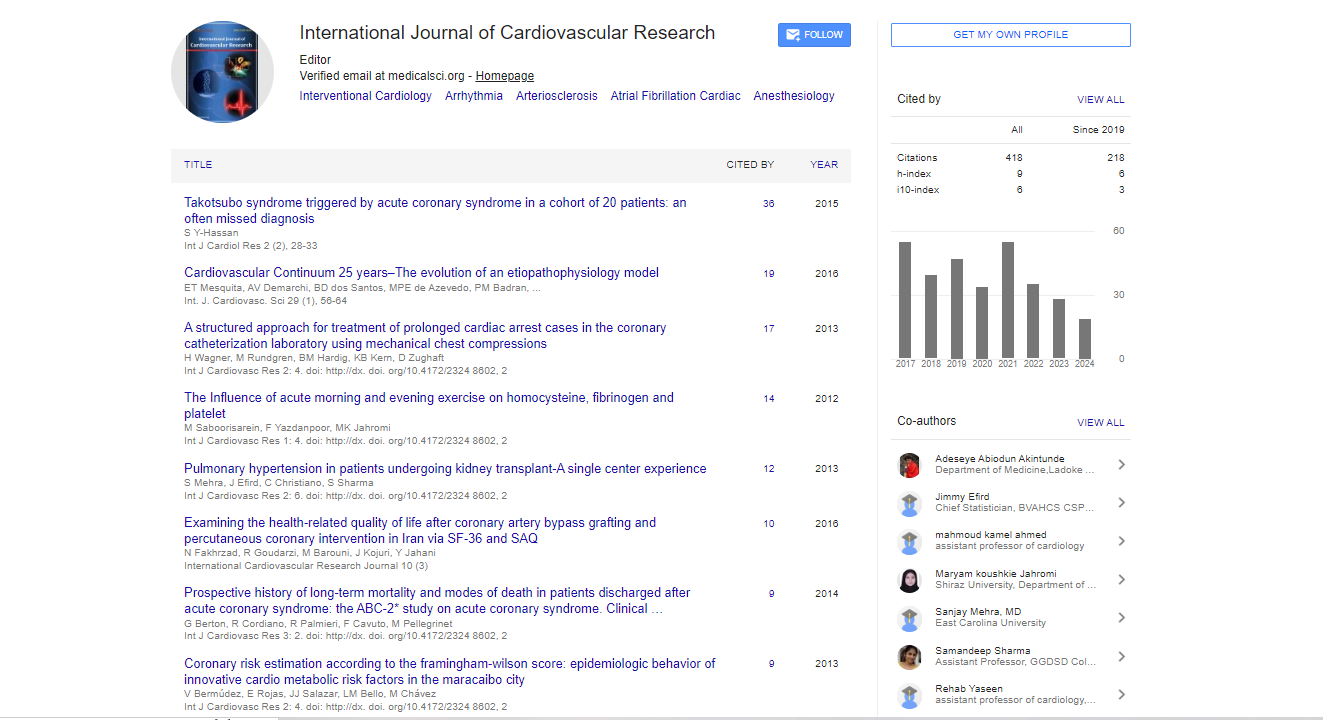Commentary, Int J Cardiol Res Vol: 13 Issue: 3
Advances and Practical Applications of Electrocardiography in Medicine
Sarper Arokia*
1Department of Emergency Medicine, University Malaysia Sabah, Sabah, Malaysia
*Corresponding Author: Sarper Arokia,
Department of Emergency Medicine,
University Malaysia Sabah, Sabah, Malaysia
E-mail: arokia@ums.edu.my
Received date: 27 May, 2024, Manuscript No. ICRJ-24-144357;
Editor assigned date: 30 May, 2024, PreQC No. ICRJ-24-144357 (PQ);
Reviewed date: 13 June, 2024, QC No. ICRJ-24-144357;
Revised date: 21 June, 2024, Manuscript No. ICRJ-24-144357 (R);
Published date: 28 June, 2024, DOI: 10.4172/2324-8602.1000568
Citation: Arokia S (2024) Advances and Practical Applications of Electrocardiography in Medicine. Int J Cardiol Res 13:3.
Description
Electrocardiography (ECG) is a pivotal diagnostic tool in the field of cardiology, enabling the detection and monitoring of various heart conditions. This noninvasive procedure records the electrical activity of the heart over time, providing important information about heart rate, rhythm and other cardiac parameters. The significance of ECG lies in its ability to diagnose a range of cardiac abnormalities, from arrhythmias to myocardial infarctions, making it an indispensable instrument in clinical settings. The heart's electrical activity originates from the Sinoatrial (SA) node, the natural pacemaker of the heart and propagates through the atria to the Atrioventricular (AV) node, the bundle of His and finally through the Purkinje fibers to the ventricular myocardium. This sequence of electrical depolarization and repolarization generates the characteristic waves seen on an ECG tracing. An ECG records this electrical activity via electrodes placed on the skin at specific anatomical locations. Standard ECGs use a 12 lead system, comprising three limb leads (I, II, III), three augmentedlimb leads (aVR, aVL, aVF) and six precordial leads (V1- V6). Each lead provides a unique perspective on the heart's electrical activity, allowing comprehensive analysis of the heart’s function.
Components of an ECG
The ECG tracing consists of several key components such as, the P wave, the QRS complex, the T wave and occasionally the U wave. The P wave represents atrial depolarization, the QRS complex corresponds to ventricular depolarization and the T wave reflects ventricular repolarization. The U wave, when present, is thought to represent repolarization of the Purkinje fibers.
The P wave is typically small and smooth, lasting less than 0.12 seconds. Abnormalities in the P wave can indicate atrial enlargement or other atrial abnormalities. The QRS complex is larger than the P wave and lasts between 0.06 and 0.10 sec. A prolonged QRS duration can suggest bundle branch block or ventricular hypertrophy. The T wave is usually upright in most leads and represents ventricular repolarization. Abnormal T wave morphology can indicate ischemia, electrolyte imbalances, or other cardiac conditions. The ST segment should be isoelectric (flat) and deviations from this can signify myocardial ischemia or infarction. The QT interval, measured from the beginning of the QRS complex to the end of the T wave, varies with heart rate and must be corrected for accurate assessment. Prolongation of the QT interval can predispose to dangerous arrhythmias.
ECGs are fundamental in diagnosing a variety of cardiac conditions. ECG is the gold standard for identifying arrhythmias, such as atrial fibrillation, atrial flutter and ventricular tachycardia. It allows clinicians to determine the origin, rate and regularity of abnormal rhythms, guiding appropriate management. During an acute myocardial infarction, characteristic changes in the ST segment, T wave and Q wave can be observed. ECG is essential for the early detection and management of ischemic events, influencing treatment decisions such as thrombolysis or percutaneous coronary intervention. Abnormalities in potassium, calcium and magnesium levels can manifest on an ECG, aiding in the diagnosis and treatment of electrolyte disorders. Conditions like hypertrophic cardiomyopathy, dilated cardiomyopathy and congenital heart diseases can present with distinct ECG patterns, assisting in their identification and management. ECG is essential for monitoring patients with known heart conditions, evaluating the effectiveness of treatments and assessing for complications such as drug-induced arrhythmias or recurrent ischemia. Technological advancements have significantly enhanced the utility of ECG. Digital ECG machines offer superior signal quality, automated interpretation algorithms and integration with Electronic Health Records (EHRs). Ambulatory ECG monitoring, including Holter monitors and implantable loop recorders, allows continuous recording over extended periods, capturing intermittent arrhythmias and other transient cardiac events. Moreover, the development of smartphone based ECG devices and wearable technology has altered cardiac monitoring, enabling real-time ECG recording and transmission, facilitating remote patient management and potentially improving results through early detection of abnormalities. Despite its numerous advantages, ECG has limitations. It provides only a overview of the heart's electrical activity and may not collect transient or intermittent abnormalities. Its interpretation can be difficult, requiring expertise to distinguish between benign variants and pathological changes. Additionally, ECG is insensitive to certain cardiac conditions, such as early stage coronary artery disease, necessitating supplementary diagnostic modalities like echocardiography, cardiac Magnetic Resonance Imaging (MRI) , or stress testing.
Conclusion
Electrocardiography remains basis of cardiac diagnostics, offering invaluable insights into the heart's electrical activity. Its role in the early detection, diagnosis and management of a wide range of cardiac conditions underscores its importance in both clinical practice and study. Continued advancements in ECG technology and interpretation to increase its diagnostic accuracy and utility, ultimately improving patient care and outcomes.
 Spanish
Spanish  Chinese
Chinese  Russian
Russian  German
German  French
French  Japanese
Japanese  Portuguese
Portuguese  Hindi
Hindi 



